2014 NISSAN GT-R maintenance
[x] Cancel search: maintenancePage 21 of 354

GTR-14GT-R Overview
the vehicle if coolant temperatures are extremely
high. Drive the vehicle at 37 to 50 MPH (60 to
80 km/h), in 5th or 6th gear for 2 to 3 miles (3 to
5 km) and then stop the engine.
Refueling precautions
WARNING
Do not attempt to top off the fuel tank
after the fuel pump nozzle shuts off
automatically. Continued refueling may
cause fuel overflow, resulting in fuel
spray and possibly a fire. The fuel tank
is full at the first automatic shutoff.
To maximize vehicle performance, the fuel tank is
located as low as possible to lower the vehicle
center of gravity. The tank is also divided into
two parts. This fuel tank design causes higher
pressures inside the tank than other vehicles so
fuel spillage is possible by trying to top off the
fuel tank after automatic shutoff.
The fuel tank pressure is higher when the vehicle
is hot, especially if the tank is more than half full.
If the cap is opened when the vehicle is hot, it
may cause fuel spray and there may be a hissing
noise. Open the cap slowly, releasing the
pressure from the tank gradually. Also, if the vehicle is refueled when the vehicle is hot, the
fuel pump may automatically shut off before the
tank is full. This does not indicate that there is a
malfunction. Refuel slowly or refuel after the
vehicle has cooled.
INSPECTION AND ADJUSTMENTS
BEFORE DRIVING
The information and specifications in this
section apply only when engaging in
performance driving.
Fluids
.
Check the engine, transmission, differential
and under vehicle surfaces for oil and
coolant leaks.
. Check the fluid levels and adjust as neces-
sary using the specified fluid as described
under the conditions listed in this section.
(
“Recommended fluids and mainte-
nance interval” page GTR-20 ) If you do
not drive under the conditions listed, refer to
the 2014 NISSAN Service and Maintenance
Guide.
. NISSAN recommends to adjust the engine
oil level
*1to be 0.39 in (10 mm) (1/8 gal
(0.5 liters))
*2below the H mark on the
engine oil dipstick. (
*3range is 1.18 in (30
mm)) Before checking the oil level, run the
engine until it reaches operating tempera-
ture and wait at least 5 minutes after turning
off the engine. Make sure the oil level always
remains above the L mark.
When the vehicle is delivered, the engine oil
is set to “H- 0.39 in (10 mm)” for optimal
high performance driving.
. Some amount of oil is consumed by your
engine under normal operating conditions,
and oil consumption by itself does not
Page 25 of 354
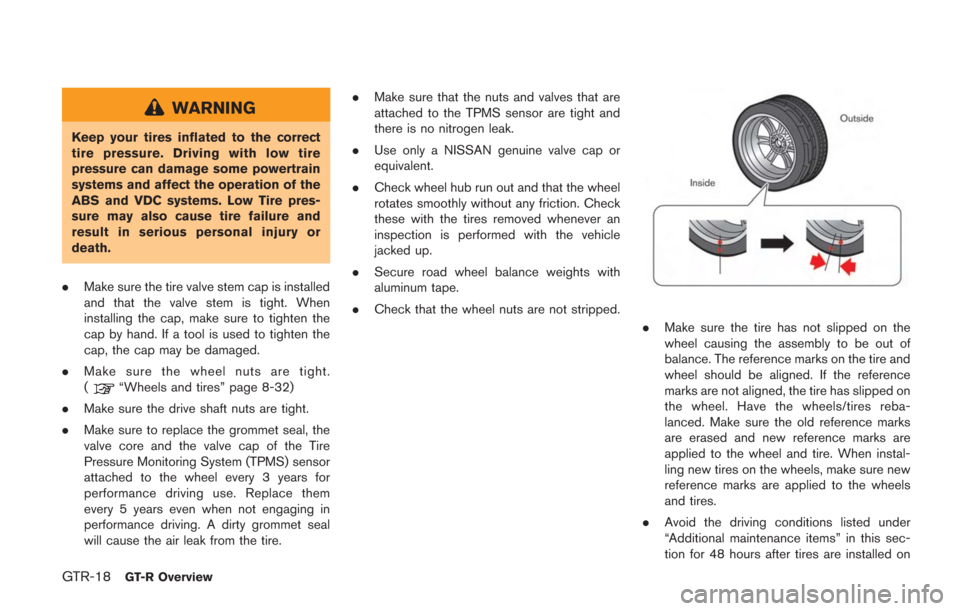
GTR-18GT-R Overview
WARNING
Keep your tires inflated to the correct
tire pressure. Driving with low tire
pressure can damage some powertrain
systems and affect the operation of the
ABS and VDC systems. Low Tire pres-
sure may also cause tire failure and
result in serious personal injury or
death.
. Make sure the tire valve stem cap is installed
and that the valve stem is tight. When
installing the cap, make sure to tighten the
cap by hand. If a tool is used to tighten the
cap, the cap may be damaged.
. Make sure the wheel nuts are tight.
(
“Wheels and tires” page 8-32)
. Make sure the drive shaft nuts are tight.
. Make sure to replace the grommet seal, the
valve core and the valve cap of the Tire
Pressure Monitoring System (TPMS) sensor
attached to the wheel every 3 years for
performance driving use. Replace them
every 5 years even when not engaging in
performance driving. A dirty grommet seal
will cause the air leak from the tire. .
Make sure that the nuts and valves that are
attached to the TPMS sensor are tight and
there is no nitrogen leak.
. Use only a NISSAN genuine valve cap or
equivalent.
. Check wheel hub run out and that the wheel
rotates smoothly without any friction. Check
these with the tires removed whenever an
inspection is performed with the vehicle
jacked up.
. Secure road wheel balance weights with
aluminum tape.
. Check that the wheel nuts are not stripped.
.Make sure the tire has not slipped on the
wheel causing the assembly to be out of
balance. The reference marks on the tire and
wheel should be aligned. If the reference
marks are not aligned, the tire has slipped on
the wheel. Have the wheels/tires reba-
lanced. Make sure the old reference marks
are erased and new reference marks are
applied to the wheel and tire. When instal-
ling new tires on the wheels, make sure new
reference marks are applied to the wheels
and tires.
. Avoid the driving conditions listed under
“Additional maintenance items” in this sec-
tion for 48 hours after tires are installed on
Page 26 of 354
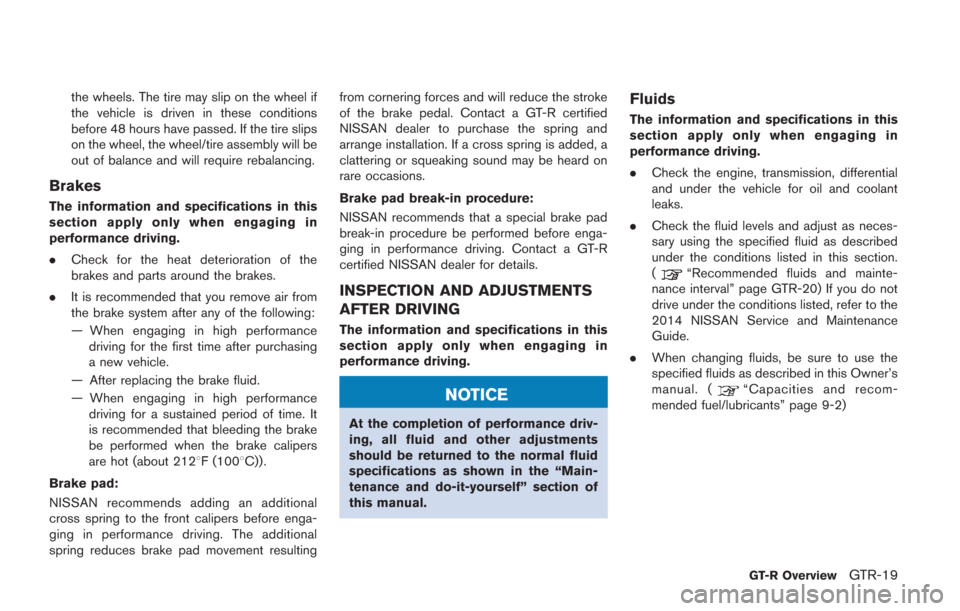
the wheels. The tire may slip on the wheel if
the vehicle is driven in these conditions
before 48 hours have passed. If the tire slips
on the wheel, the wheel/tire assembly will be
out of balance and will require rebalancing.
Brakes
The information and specifications in this
section apply only when engaging in
performance driving.
.Check for the heat deterioration of the
brakes and parts around the brakes.
. It is recommended that you remove air from
the brake system after any of the following:
— When engaging in high performance
driving for the first time after purchasing
a new vehicle.
— After replacing the brake fluid.
— When engaging in high performance driving for a sustained period of time. It
is recommended that bleeding the brake
be performed when the brake calipers
are hot (about 2128F (1008C)) .
Brake pad:
NISSAN recommends adding an additional
cross spring to the front calipers before enga-
ging in performance driving. The additional
spring reduces brake pad movement resulting from cornering forces and will reduce the stroke
of the brake pedal. Contact a GT-R certified
NISSAN dealer to purchase the spring and
arrange installation. If a cross spring is added, a
clattering or squeaking sound may be heard on
rare occasions.
Brake pad break-in procedure:
NISSAN recommends that a special brake pad
break-in procedure be performed before enga-
ging in performance driving. Contact a GT-R
certified NISSAN dealer for details.
INSPECTION AND ADJUSTMENTS
AFTER DRIVING
The information and specifications in this
section apply only when engaging in
performance driving.
NOTICE
At the completion of performance driv-
ing, all fluid and other adjustments
should be returned to the normal fluid
specifications as shown in the “Main-
tenance and do-it-yourself” section of
this manual.
Fluids
The information and specifications in this
section apply only when engaging in
performance driving.
.
Check the engine, transmission, differential
and under the vehicle for oil and coolant
leaks.
. Check the fluid levels and adjust as neces-
sary using the specified fluid as described
under the conditions listed in this section.
(
“Recommended fluids and mainte-
nance interval” page GTR-20) If you do not
drive under the conditions listed, refer to the
2014 NISSAN Service and Maintenance
Guide.
. When changing fluids, be sure to use the
specified fluids as described in this Owner’s
manual. (
“Capacities and recom-
mended fuel/lubricants” page 9-2)
GT-R OverviewGTR-19
Page 27 of 354
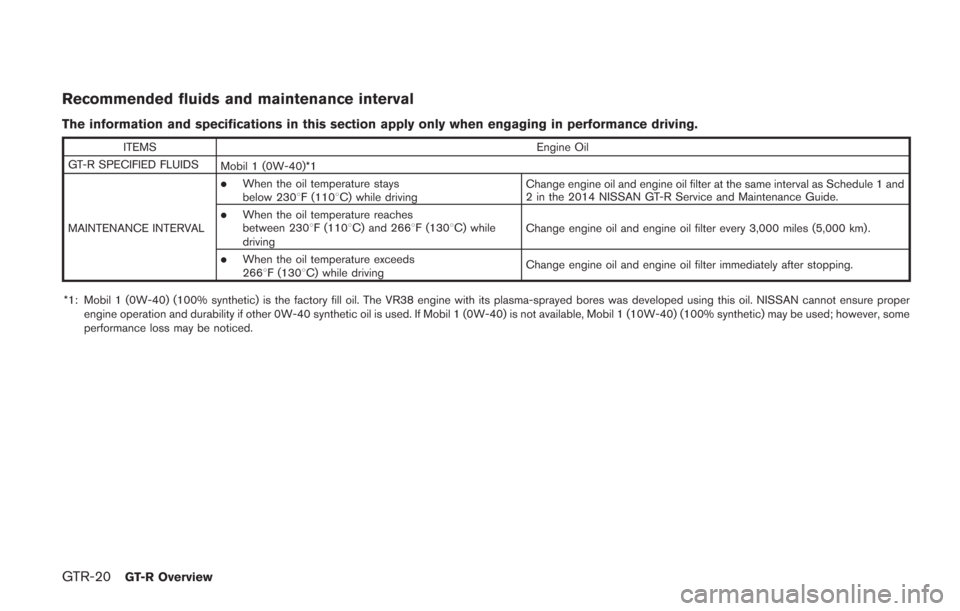
GTR-20GT-R Overview
Recommended fluids and maintenance interval
The information and specifications in this section apply only when engaging in performance driving.
ITEMSEngine Oil
GT-R SPECIFIED FLUIDS Mobil 1 (0W-40)*1
MAINTENANCE INTERVAL
.When the oil temperature stays
below 2308F (1108C) while driving Change engine oil and engine oil filter at the same interval as Schedule 1 and
2 in the 2014 NISSAN GT-R Service and Maintenance Guide.
.When the oil temperature reaches
between 2308F (1108C) and 2668F (1308C) while
drivingChange engine oil and engine oil filter every 3,000 miles (5,000 km).
.When the oil temperature exceeds
2668F (1308C) while driving
Change engine oil and engine oil filter immediately after stopping.
*1: Mobil 1 (0W-40) (100% synthetic) is the factory fill oil. The VR38 engine with its plasma-sprayed bores was developed using this oil. NISSAN cannot ensure proper engine operation and durability if other 0W-40 synthetic oil is used. If Mobil 1 (0W-40) is not available, Mobil 1 (10W-40) (100% synthetic) may be used; however, some
performance loss may be noticed.
Page 28 of 354
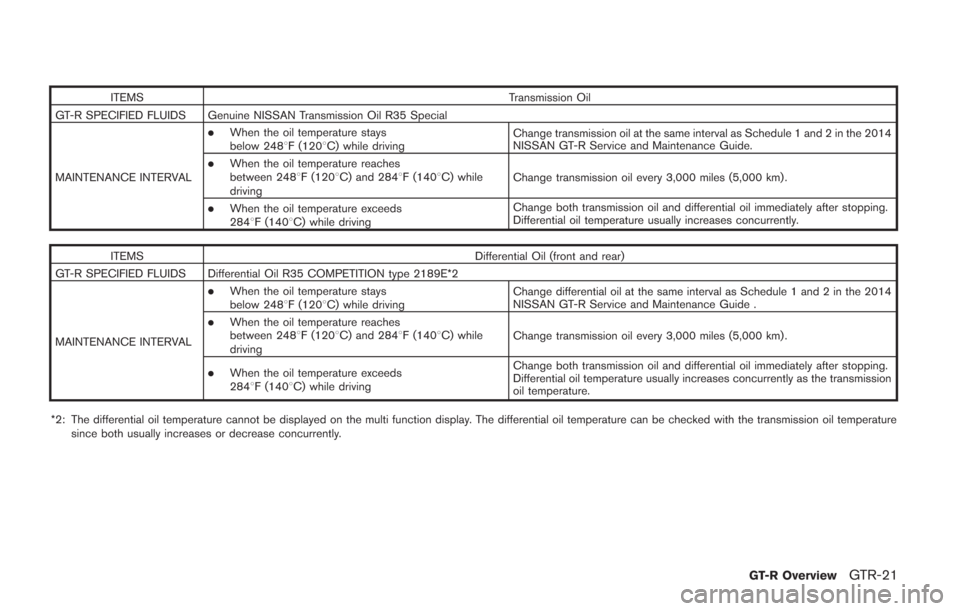
ITEMSTransmission Oil
GT-R SPECIFIED FLUIDS Genuine NISSAN Transmission Oil R35 Special
MAINTENANCE INTERVAL
.When the oil temperature stays
below 2488F (1208C) while driving Change transmission oil at the same interval as Schedule 1 and 2 in the 2014
NISSAN GT-R Service and Maintenance Guide.
.When the oil temperature reaches
between 2488F (1208C) and 2848F (1408C) while
drivingChange transmission oil every 3,000 miles (5,000 km) .
.When the oil temperature exceeds
2848F (1408C) while drivingChange both transmission oil and differential oil immediately after stopping.
Differential oil temperature usually increases concurrently.
ITEMS Differential Oil (front and rear)
GT-R SPECIFIED FLUIDS Differential Oil R35 COMPETITION type 2189E*2
MAINTENANCE INTERVAL
.When the oil temperature stays
below 2488F (1208C) while driving Change differential oil at the same interval as Schedule 1 and 2 in the 2014
NISSAN GT-R Service and Maintenance Guide .
.When the oil temperature reaches
between 2488F (1208C) and 2848F (1408C) while
drivingChange transmission oil every 3,000 miles (5,000 km) .
.When the oil temperature exceeds
2848F (1408C) while drivingChange both transmission oil and differential oil immediately after stopping.
Differential oil temperature usually increases concurrently as the transmission
oil temperature.
*2: The differential oil temperature cannot be displayed on the multi function display. The differential oil temperature can be checked with the transmission oil temperature since both usually increases or decrease concurrently.
GT-R OverviewGTR-21
Page 29 of 354
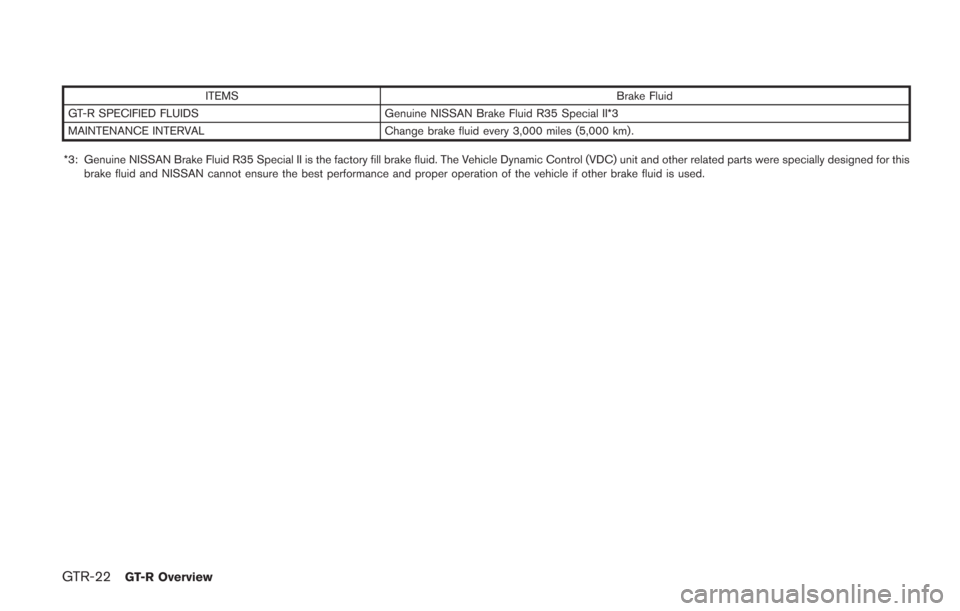
GTR-22GT-R Overview
ITEMSBrake Fluid
GT-R SPECIFIED FLUIDS Genuine NISSAN Brake Fluid R35 Special II*3
MAINTENANCE INTERVAL Change brake fluid every 3,000 miles (5,000 km).
*3: Genuine NISSAN Brake Fluid R35 Special II is the factory fill brake fluid. The Vehicle Dynamic Control (VDC) unit and other related parts were specially designed for this brake fluid and NISSAN cannot ensure the best performance and proper operation of the vehicle if other brake fluid is used.
Page 50 of 354
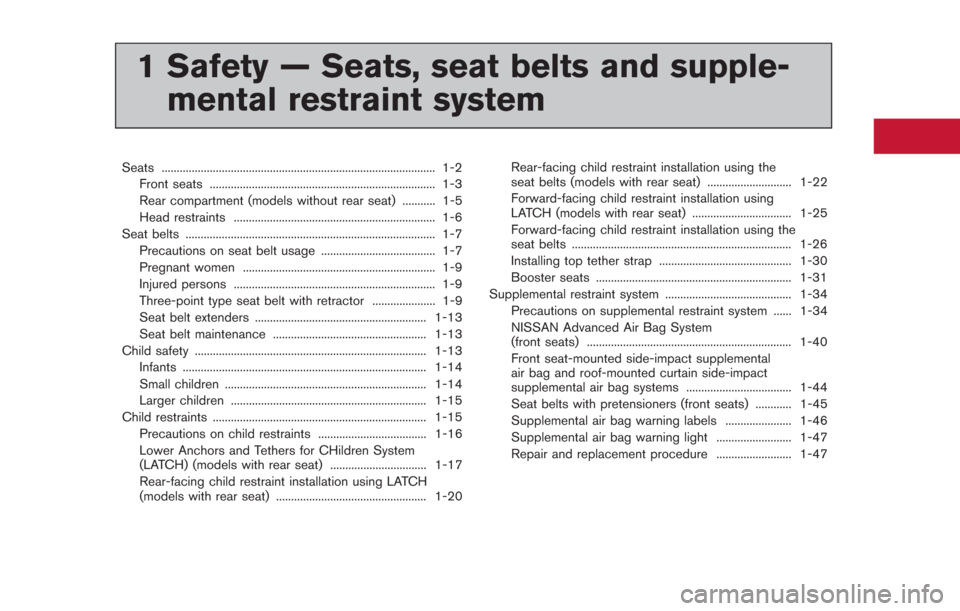
1 Safety — Seats, seat belts and supple-mental restraint system
Seats ........................................................................\
................... 1-2
Front seats ........................................................................\
... 1-3
Rear compartment (models without rear seat) ........... 1-5
Head restraints ................................................................... 1-6
Seat belts ........................................................................\
........... 1-7 Precautions on seat belt usage ...................................... 1-7
Pregnant women ................................................................ 1-9
Injured persons ................................................................... 1-9
Three-point type seat belt with retractor ..................... 1-9
Seat belt extenders ......................................................... 1-13
Seat belt maintenance ................................................... 1-13
Child safety ........................................................................\
..... 1-13 Infants ........................................................................\
......... 1-14
Small children ................................................................... 1-14
Larger children ................................................................. 1-15
Child restraints ....................................................................... 1-15
Precautions on child restraints .................................... 1-16
Lower Anchors and Tethers for CHildren System
(LATCH) (models with rear seat) ................................ 1-17
Rear-facing child restraint installation using LATCH
(models with rear seat) .................................................. 1-20 Rear-facing child restraint installation using the
seat belts (models with rear seat) ............................ 1-22
Forward-facing child restraint installation using
LATCH (models with rear seat) ................................. 1-25
Forward-facing child restraint installation using the
seat belts ........................................................................\
. 1-26
Installing top tether strap ............................................ 1-30
Booster seats ................................................................. 1-31
Supplemental restraint system .......................................... 1-34 Precautions on supplemental restraint system ...... 1-34
NISSAN Advanced Air Bag System
(front seats) .................................................................... 1-40
Front seat-mounted side-impact supplemental
air bag and roof-mounted curtain side-impact
supplemental air bag systems ................................... 1-44
Seat belts with pretensioners (front seats) ............ 1-45
Supplemental air bag warning labels ...................... 1-46
Supplemental air bag warning light ......................... 1-47
Repair and replacement procedure ......................... 1-47
Page 62 of 354
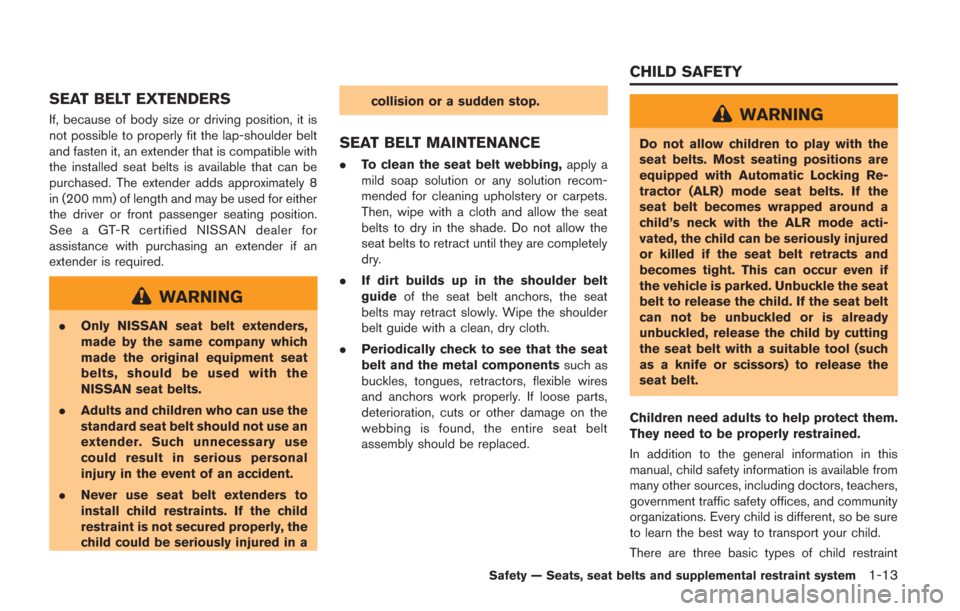
SEAT BELT EXTENDERS
If, because of body size or driving position, it is
not possible to properly fit the lap-shoulder belt
and fasten it, an extender that is compatible with
the installed seat belts is available that can be
purchased. The extender adds approximately 8
in (200 mm) of length and may be used for either
the driver or front passenger seating position.
See a GT-R certified NISSAN dealer for
assistance with purchasing an extender if an
extender is required.
WARNING
.Only NISSAN seat belt extenders,
made by the same company which
made the original equipment seat
belts, should be used with the
NISSAN seat belts.
. Adults and children who can use the
standard seat belt should not use an
extender. Such unnecessary use
could result in serious personal
injury in the event of an accident.
. Never use seat belt extenders to
install child restraints. If the child
restraint is not secured properly, the
child could be seriously injured in a collision or a sudden stop.
SEAT BELT MAINTENANCE
.
To clean the seat belt webbing, apply a
mild soap solution or any solution recom-
mended for cleaning upholstery or carpets.
Then, wipe with a cloth and allow the seat
belts to dry in the shade. Do not allow the
seat belts to retract until they are completely
dry.
. If dirt builds up in the shoulder belt
guide of the seat belt anchors, the seat
belts may retract slowly. Wipe the shoulder
belt guide with a clean, dry cloth.
. Periodically check to see that the seat
belt and the metal components such as
buckles, tongues, retractors, flexible wires
and anchors work properly. If loose parts,
deterioration, cuts or other damage on the
webbing is found, the entire seat belt
assembly should be replaced.
WARNING
Do not allow children to play with the
seat belts. Most seating positions are
equipped with Automatic Locking Re-
tractor (ALR) mode seat belts. If the
seat belt becomes wrapped around a
child’s neck with the ALR mode acti-
vated, the child can be seriously injured
or killed if the seat belt retracts and
becomes tight. This can occur even if
the vehicle is parked. Unbuckle the seat
belt to release the child. If the seat belt
can not be unbuckled or is already
unbuckled, release the child by cutting
the seat belt with a suitable tool (such
as a knife or scissors) to release the
seat belt.
Children need adults to help protect them.
They need to be properly restrained.
In addition to the general information in this
manual, child safety information is available from
many other sources, including doctors, teachers,
government traffic safety offices, and community
organizations. Every child is different, so be sure
to learn the best way to transport your child.
There are three basic types of child restraint
Safety — Seats, seat belts and supplemental restraint system1-13
CHILD SAFETY